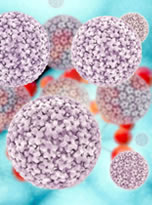Read and report vaccine reactions, harassment and failures.

Human papillomaviruses are double-stranded DNA viruses found in the squamous epithelial cells on the surface of the skin and also the mucous membranes of the body. There are more than 200 known types of human papilloma viruses (HPVs) and most are not harmful. In the majority of cases, the human immune system clears HPV infections without symptoms or complications.
More than 90 percent of those who become infected naturally clear the infection from the body within two years. Antibodies to the HPV type causing the infection remain in the body to help prevent future infections but the protection may not be life-long.
Low Risk HPV Types - About 75 percent of HPVs have been associated with non-cancerous warts (papillomas) on the hands, chest, arms and feet, such as low-risk (wart-causing) HPV types 6 and 11. Low-risk HPV types associated with genital warts differ from high-risk HPV types that can be associated with development of cancer after years of chronic infection.
High Risk HPV Types - About 40 HPV types have been found in the body’s mucosal membranes, such as the mucosal surfaces of the cervix, vagina, vulva, anus, penis, mouth and throat, including the most common high-risk HPV types 16 and 18. High-risk HPV types are associated with cancer of the cervix and five other genital and oral cancers affecting women and men if the HPV infection does not clear and becomes a chronic infection. High-risk HPV types currently include types 16, 18, 31, 33, 35, 39, 45, 51, 52, 56, 58, 59, 68, 69, 73 and 82. The National Cancer Institute states that most HPV-related cancers are cause by two HPV types, HPV-16 and HPV-18.
IMPORTANT NOTE: NVIC encourages you to become fully informed about HPV and the HPV vaccine by reading all sections in the Table of Contents , which contain many links and resources such as the manufacturer product information inserts, and to speak with one or more trusted health care professionals before making a vaccination decision for yourself or your child. This information is for educational purposes only and is not intended as medical advice.



